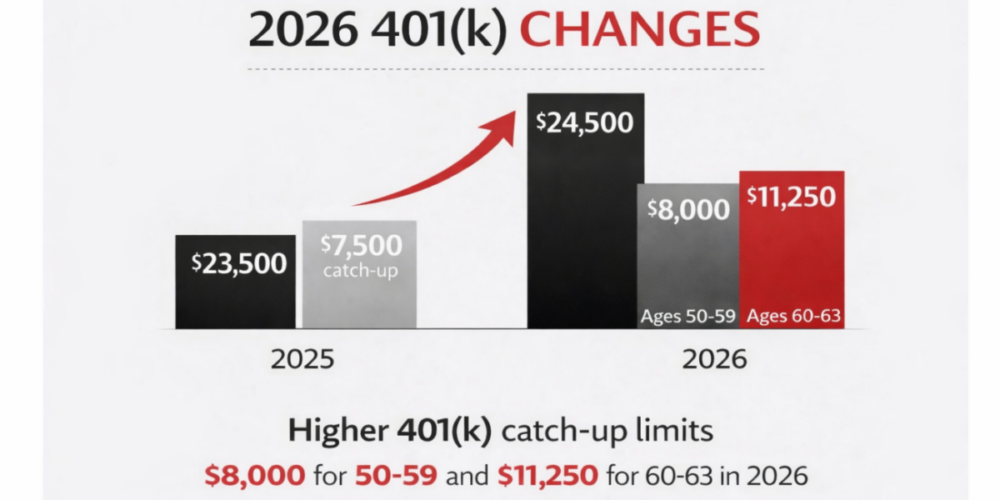Tax saving strategies 2026 go far beyond higher 401(k) limits. For…

Retirement Countdown – 5 Years Out
Your retirement countdown is on! If you are in your 50s or 60s, you are probably about 5 to 10 years from retirement (give or take). Maybe you are even just a year from retirement. Regardless of the exact timing, you are in the home stretch of a lifelong race to this exciting time of your life.
This transition is likely to present you with a host of unique challenges, exciting experiences, and complex decisions. Most people only retire once, which is why retirement can seem so daunting. You’ve never done this before.
It’s a new phase of your life, and even though many of the changes will be good, it’s still different. No matter how much you plan and how ready you think you are for retirement, it’s a change and can be a scary thing. But the time that you invest preparing and asking yourself the necessary questions will make the transition easier and more enjoyable.
3 Questions Before Retiring
1. Am I really ready to retire?
You may be thinking of the obvious retirement questions: Did I save enough to achieve my goals in retirement? How much am I able to spend? What happens if we experience another recession?
But there is much more to it than just these initial questions. Too often, soon-to-be retirees don’t examine their emotional well-being and how it will affect their daily life and routine when they retire. It turns out that roughly two-thirds of new retirees feel some type of uneasiness when entering their new stage of life.
One thing that could cause this uneasiness is the loss of career identity or the support network you had through work. Another is worry about not having a regular paycheck. Whatever your concern may be, keep in mind what you are retiring “to,” not what you are retiring “from.” Below are recommendations to consider before you say, “I’m retiring.”
- Decide if you want to keep working
- Consider volunteering
- Be a mentor
- Establish friendships well before retirement
- Include family in your retirement plan
- Tackle your bucket list
2. What is my net worth?
In order to know if you’ve saved enough and you can financially retire, it’s important to know your finances. This includes all your assets and liabilities, that go into preparing a net worth statement. Most people are surprised when they see their personal net worth statement documented for the first time. Often, total net worth is larger than they had thought! As we go through life, we tend to collect possessions that fill our houses, garages, and closets. Similarly, with our financial lives we collect accounts, assets, and debts and never put in the effort to see how the puzzle fits together and how to best build a financial plan.
One of the biggest benefits of preparing a net worth statement is to help you stop segregating certain accounts in your mind and see everything in one clear, holistic view. By looking at everything together, in one place, it allows you to see opportunities for simplifying and consolidating areas of your financial plan. It also provides you with a starting point on your financial map. It’s hard to see where you’re going if you don’t know where you’re starting.
3. How do I replace my income in retirement?
Every soon-to-be or recent retiree’s financial goals and sources of funding for those goals are unique and require detailed, tailored planning. Some might expect their basic living and other expenses to be completely supported by Social Security
and other sources of income (e.g., pensions, part-time employment), relying only minimally on their investment assets.
Usually retirees can anticipate only modest supplementary income in retirement. Most must depend on their judiciously saved investment assets to provide a paycheck through retirement. Setting aside, for now, tax minimization and other planning strategies that ought to be considered in the early years of retirement, a person’s withdrawal strategy from their investment assets is one of the most important pieces of the overall plan to be considered.
A successful retirement income withdrawal strategy must be sustainable and flexible, as you monitor the investment environment year over year. A traditional rule of thumb for setting a withdrawal rate is the four percent rule. During the first year of retirement you withdraw 4% of your portfolio assets. Then adjust that value each subsequent year for inflation. While this rule is generally sustainable in static models, in reality it may fail due to its indifference toward volatile investment returns. It ignores one of the most crucial risks facing early retirees: sequence of returns risk. This risk describes the unpredictability of market returns. This unpredictability is the reason that flexibility is so important when developing a withdrawal strategy.
It is generally more advisable to adopt a withdrawal strategy that allows for some elasticity when deciding each subsequent year’s withdrawal amount. This means that in a year when a portfolio’s value increases significantly, the withdrawal amount for that year increases as well, but only up to a maximum five percent more than the previous year. Similarly, in a year when a portfolio’s value decreases significantly, the withdrawal amount for that year may only decline by 1.5 percent from the previous year. Many retirees adopted a version of this strategy in 2020.
What should I do next?
First of all, stay tuned for our next blog that will focus on Medicare, Social Security and taxation during retirement. These are also important considerations when planning for retirement. According to a recent study by Fidelity Investments, the average total costs of healthcare for a retired couple ages 65 and living until ages 85/87 will be $285,000.¹ When people think about their retirement goals, they often overlook the expenses associated with maintaining their health.
After considering these thought-provoking questions, it’s a good idea to write down or journal the details of your retirement plan. This will allow you to begin to see the big picture of how the various pieces fit together. If you decide to work with an advisor, this will also be a great way to show them all the critical elements of your financial life in one place.
Another next step would be to get an assessment of your overall financial health. Much like an annual physical from your doctor, a financial review is an exercise that provides you an objective and wide-ranging audit of your current financial health. It helps prioritize the aspects of your financial situation that need attention so you can create a plan of action.
Sources: ¹Fidelity
M & A Consulting Group, LLC, doing business as CAM Investor Solutions is an SEC registered investment adviser. As a fee-only firm, we do not receive commissions nor sell any insurance products. We provide financial planning and investment information that we believe to be useful and accurate. However, there cannot be any guarantees.
This blog has been provided solely for informational purposes and does not represent investment advice. Nor does it provide an opinion regarding fairness of any transaction. It does not constitute an offer, solicitation or a recommendation to buy or sell any particular security or instrument or to adopt any investment strategy.
Past performance is not a guarantee of future results. Diversification does not eliminate the risk of market loss. Tax planning and investment illustrations are provided for educational purposes and should not be considered tax advice or recommendations. Investors should seek additional advice from their financial advisor or tax professional.



